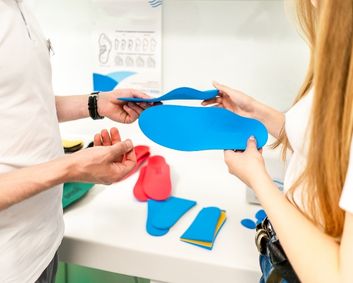- Call us now
- (03) 9449 9393
Menu

Foot Orthotics
Foot orthoses, more commonly known as insoles, are issued for the treatment of biomechanical issues affecting the lower limb. By introducing these foot supports into footwear, clinicians can redistribute pressure, provide joint realignment, improve muscular function, correct postural issues, and ultimately effectively treat any symptoms associated with lower limb related disorders.
Foot orthoses are generally classified into one of two categories, prefabricated or customised. The prefabricated type of orthoses provides a generic support to the feet that can generally be heat adjusted to provide a good degree of support. They normally come in both three quarter and full length options and are available from health care professionals, sports stores and pharmacies. Prefabricated insoles are a much cheaper alternative than custom foot orthoses however in many cases they can very successfully treat anomalies and alleviate patient symptoms. This type of insole can also be purchased in both hard plastic compounds such as polypropylene (PP) and softer rubber composites such as ethylene- vinyl acetate (EVA). Customised Foot Orthoses are fabricated from an impression of each the left and right foot and are unique to each patient. The foot is generally captured with plaster, foam or digital scan to enable fabrication of an arch support that is specific to the mould being used. This type of insole provides superior support to any other insole as it is very accurate with respect to the prescribed support that has been formulated by the clinicians in an attempt to correct any anomalies. Similar to prefabricated insoles, custom foot insoles can be made from hard compounds such as PP and carbon fibre, and alternatively softer rubber composites such as EVA.
Foot Orthoses aim at correcting mechanical anomalies by repositioning the feet to minimise stress and/or strain resulting from malignment. They can also be simply prescribed to offer pressure redistribution in the event where unnecessary load is being localised to an area and causing harm such as ulceration. Generally, insoles that are designed to aid athletic performance are fabricated from harder plastics such as carbon fibre. This type of material facilitates a more efficient power transfer between the foot and footwear. These insole types are very commonly used in athletics and cycling. Alternatively, insoles fabricated from softer rubbers such as EVA aim at absorbing shock specifically associated with ground reaction forces and the redistribution of forces being exerted under specific structures of the feet. These softer types of insoles are more commonly used in people for standing for long periods of time, post operative surgically recovered and pressure distribution from ulceration sites in patients suffering from diabetes.
Insoles have been developed to treat an array of issues affecting the feet. Depending on the situation which needs addressing, insoles help alleviate symptoms via different mechanisms. Pathologies affecting the lower limbs which are commonly treated with insoles include the following:
Flat Feet, medically coined pes planus, is a term used to decrsibe a foot which does not visually display a medial arch. This foot type is associated with rearfoot portion and medially bulging of the navicular bone. This specific foot type can contribute to an array of lower limb musculoskeletal conditions such as plantar fasciitis, posterior tibial dysfunction, Achilles tendinopathy, mid foot arthritis, and hallux limits/rigidus. Pes planus can also contribute to issues not only affecting the feet but also the lower legs, knees, hips and back. Therefore, foot insoles are used to correct postural and position issues that may exist and untimely achieve symptom reduction
High arched feet, medically coined pes cavus, is a term used to describe a foot with a noticeably high instep. Those people displaying pes cavus often experience forefoot pain due to an increase in load under the metatarsophalangeal joins. Conditions commonly include metatarsalgia, sesamoiditis, Morton’s neuroma, hard corns, and diffuse areas hyperkeratotic tissue. This specific foot type also displays poor shock absorption as a result of increased rigidity. Foot insoles prescribed for the treatment of high arched feet aim at increasing surface area and pressure redistribution to achieve symptom reduction
Arthritic foot types can commonly be classified into either Rheumatoid or Osteo. Rheumatoid arthritis is an autoimmune disease that results in joint destruction. The condition is characterised by severe foot pain, joint deformity, and functional disability. Significant arthritic changes are normally evidenced in the metatarsal region of the feet. Foot orthoses attempt to redistribute pressure minimising force specifically under forefoot. Alternatively, Osteoarthritis is a degenerative condition that results in significant foot pain and joint destruction. It commonly affects the first metatarsophalangeal joint and the metatarsocunieform joints. Orthoses for the treatment of this arthritic condition aim at supporting the arch and restricting joint range of motion. This can commonly be achieved via introducing semi-rigid foot orthoses or stiff carbon plates under the patient’s feet.